The minute I stepped out of my car I could hear the distinct sounds of monkeys hooting and hollering as they played amongst each other. Without warning, an ear piercing whistle blows very close to where I parked my car. The Lincoln Children’s Zoo Train thunders past, just feet from the parking lot.
 As I approached the gates, I could hear music that put a spring in my step as I went to investigate this new zoo. At the gate, the lady said, “Just one?” I replied with a hushed, “Yes,” as I unwillingly handed her my hard earned money. As I entered the main area of the zoo, the first thing I encountered was the map. I took a close look at the map to see where the animals that interested me most were located in this unfamiliar zoo.
As I approached the gates, I could hear music that put a spring in my step as I went to investigate this new zoo. At the gate, the lady said, “Just one?” I replied with a hushed, “Yes,” as I unwillingly handed her my hard earned money. As I entered the main area of the zoo, the first thing I encountered was the map. I took a close look at the map to see where the animals that interested me most were located in this unfamiliar zoo.The first animal exhibit I encountered on my stroll through the zoo was the Bald Eagle exhibit. The exhibit was a very small enclosure. To reach the viewing area, you had to open a door. Inside this door, was an area to listen to the calls that Bald Eagles make when communicating with each other. Beyond this feature, there was another door through which you stepped to stand on the viewing area for this exhibit. Inside the habitat, sat two majestic and beautiful Bald Eagles.
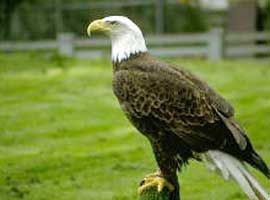 Both sat on a make shift nest that had been created by the zoo staff. Next to the nest, was a shelter for the eagles to use during harsh weather conditions. A member of the zoo staff stepped onto the viewing area with me and said, “Isn’t it sad, to see these beautiful birds just sitting in here?” At first I was taken back by the stranger’s comments but finally I mustered a reply, “It’s very sad. How did these two get here?” He replied quickly, “These two have been hurt in the wild. One was shot and lost part of its wing and the other was injured and will never be able to survive in the wild.” I stood there and look at the beautiful birds for a while not saying anything. Finally I commented, “A bird as majestic as these shouldn’t be subject to that type of human abuse.” The young man told me, “It happens all the time.” I told the man thank you for sharing that information with me and moved on to the next exhibit on my list to visit.
Both sat on a make shift nest that had been created by the zoo staff. Next to the nest, was a shelter for the eagles to use during harsh weather conditions. A member of the zoo staff stepped onto the viewing area with me and said, “Isn’t it sad, to see these beautiful birds just sitting in here?” At first I was taken back by the stranger’s comments but finally I mustered a reply, “It’s very sad. How did these two get here?” He replied quickly, “These two have been hurt in the wild. One was shot and lost part of its wing and the other was injured and will never be able to survive in the wild.” I stood there and look at the beautiful birds for a while not saying anything. Finally I commented, “A bird as majestic as these shouldn’t be subject to that type of human abuse.” The young man told me, “It happens all the time.” I told the man thank you for sharing that information with me and moved on to the next exhibit on my list to visit.As I approached the tank to view the River Otter, I saw him swimming laps, gracefully in his pool. Every once in a while he would pop his head out of the water to catch a breath of air. He would swim from the edge of the water, under a log in the pool, and then push himself off the side wall headed back to the edge of the water where he would immediately start his paddling again.
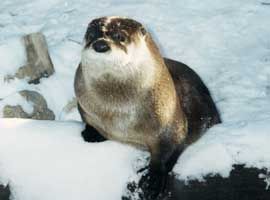 As he swam, he streamlined his body and used his powerful hind legs to propel himself swiftly through the water. As I watched him swim his laps, something caught my eye near the front of his tank. It was a dull red ball that had multiple, small tooth marks on it from playful bites provided by the otter. He seemed uninterested in the ball and more interested in watching what the passersby and I were doing. Every time he swam passed the glass, he would look out at the people and children walking by adn then glance at me sitting and watching. As I got up and decided to move on to another exhibit, the playful otter got out of the water and followed me to the opposite side of his enclosure. Maybe he was asking me to stay and watch his beautiful swimming techniques. He slowly turned and got back into the pool, he realized that I wasn’t going to return to my resting place where I had watched him swim multiple laps around his pool ealier.
As he swam, he streamlined his body and used his powerful hind legs to propel himself swiftly through the water. As I watched him swim his laps, something caught my eye near the front of his tank. It was a dull red ball that had multiple, small tooth marks on it from playful bites provided by the otter. He seemed uninterested in the ball and more interested in watching what the passersby and I were doing. Every time he swam passed the glass, he would look out at the people and children walking by adn then glance at me sitting and watching. As I got up and decided to move on to another exhibit, the playful otter got out of the water and followed me to the opposite side of his enclosure. Maybe he was asking me to stay and watch his beautiful swimming techniques. He slowly turned and got back into the pool, he realized that I wasn’t going to return to my resting place where I had watched him swim multiple laps around his pool ealier.From the Otter pool I moved to the area of the zoo called the First Hand Farm. The First Hand Farm had a strong smell that could be easily associated with any farm, that of manure. It was putrid and hung in the air and masked any good scent in the area. The smell was almost overwhelming. There were a lot of things for younger kids to do in this area. First of all, everyone could feel the texture of pelts from the different kinds of animals. The kids could have animal tattoos painted on their faces for fifty cents. Kids could enjoy a leisurely ride on a donkey or horse of their choice for a small fee. Also in the First Hand Farm, there were enclosures for animals such as goats, llamas, chickens, donkeys, and horses. There were four enclosures, three of them held chickens, llamas, and goats, and the fourth held the horses and donkeys. Between the three enclosures holding the chickens, llamas, and goats a wooden walking bridge had been erected for the goats to cross back and forth between the different enclosures. Most of the goats preferred to sit and sun on the walkway, while others walked over them between the different pens. On the floor of the enclosures, goats herded around little openings in the fence where kids could feed them by hand and pet them. For fifty cents, one could purchase food pellets that the goats consumed rather quickly and looked at the children pleadingly for more. The kids turned to ask their parents for two more quarters. The human kids ran to and from their parents very quickly, almost at a dead sprint, back to the little machine that dispensed the pellets. The First Hand Farm was very child oriented and fit the zoo well. The kids got a little overwhelming after a while and I decided to move on to other exhibits in the zoo that might be a little more interesting to me.
The next exhibit that caught my attention was the Harbor Seal pool. Two seals were swimming quick laps around the pool only pausing to take momentary breaths of air. They used their powerful tails and flippers to propel themselves about the pool.
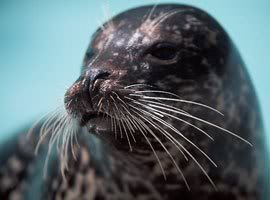 As I sat on the bench and watched them swim their numerous laps, I could hear the sound of waves crashing against the shore and other seals barking. I looked around to see a speaker placed on top of the pool house just beyond the enclosure. In the center of the pool was a rock for the seals to bask in the sun on. On this beautiful summer day, neither was interested in sitting and enjoying the sun. They were both enjoying their dip in the pool. As I sat watching the seals, there was something in the bushes that caught my eye. It was a bird, not just a common sparrow that you see every day but a big bird.
As I sat on the bench and watched them swim their numerous laps, I could hear the sound of waves crashing against the shore and other seals barking. I looked around to see a speaker placed on top of the pool house just beyond the enclosure. In the center of the pool was a rock for the seals to bask in the sun on. On this beautiful summer day, neither was interested in sitting and enjoying the sun. They were both enjoying their dip in the pool. As I sat watching the seals, there was something in the bushes that caught my eye. It was a bird, not just a common sparrow that you see every day but a big bird. It took me less than a minute to realize what that bird was that I was looking at, it was a peacock. Actually it was two peacocks, one male and one female. The male had its big, long train of blue, black, and green feathers flowing behind it, while the female was plain brown. The male seemed intent on trying to catch the female’s attention, slowly moving towards her as she ate. He tried everything except spreading his giant fan of feathers, his signature mating call.
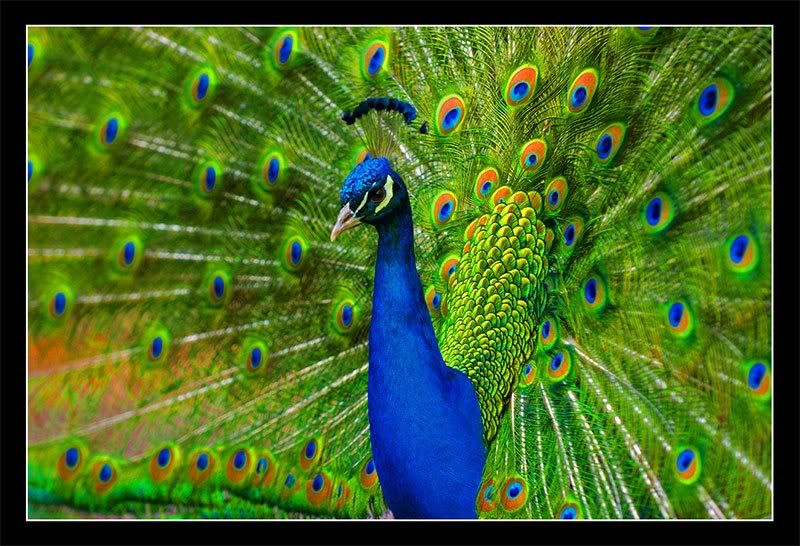 A small boy walked by and startled the male and he gave out a loud call that could be heard throughout the park. Then a pesky squirrel caught my attention, as he hurriedly ran across the path in front of a group of people walking between exhibits. I noticed that he had a nut in his mouth as he ran. He stopped once he reached the other side of the path as if to pray to God, thanking him for allowing him to cross without becoming road kill. After his quick prayer, he proceeded to the base of a tree trunk and began to dig a hole in which to bury his newly found nut. He dug for a minute or so and decided that the hole was deep enough and carefully placed the nut inside the hole and covered it with dirt. There were also various other birds that were allowed to roam free about the park. Small food dishes had been set out sporadically about the park for these birds to eat.
A small boy walked by and startled the male and he gave out a loud call that could be heard throughout the park. Then a pesky squirrel caught my attention, as he hurriedly ran across the path in front of a group of people walking between exhibits. I noticed that he had a nut in his mouth as he ran. He stopped once he reached the other side of the path as if to pray to God, thanking him for allowing him to cross without becoming road kill. After his quick prayer, he proceeded to the base of a tree trunk and began to dig a hole in which to bury his newly found nut. He dug for a minute or so and decided that the hole was deep enough and carefully placed the nut inside the hole and covered it with dirt. There were also various other birds that were allowed to roam free about the park. Small food dishes had been set out sporadically about the park for these birds to eat. As I sat there and watched all these animals scurry back and forth, I began to think about how these animals ended up here. This made me wonder how the zoo keepers had decided what animals could wander freely throughout the park. Are all these animals, just like the bald eagles, here because they can’t survive in the wild on their own? I also began to think about how this zoo was different than other zoos that I had visited in the past, including the Henry Doorly Zoo in Omaha and the San Diego Zoo. It made me question the institutional values of zoos and if they were limited by their monetary resources.
The peacocks and other birds are allowed to roam free because they can’t fly; their wings have been clipped or injured. Allowing some critters to roam free adds a feeling of freedom to the zoo. With animals that roam freely, we can see how they interact with people in the zoo. The zoo can’t allow all the other animals to roam the park because they would be a liability to the guests. Birds and squirrels don’t pose a threat because most often times they run when near a human. These decisions make the most sense; if animals like the leopard were allowed to move about freely, there would be injuries and deaths in the park, both human and animal. No zoo wants to deal with problems like that.
Quite a few of the animals that end up in zoos or preserves are the ones that have been injured so severely, that they wouldn’t be able to survive on their own any more. Like the bald eagles, many have injuries that limit their abilities to survive in the wild. Those two bald eagles can’t fly anymore which wouldn't allow them to hunt to survive and they'd be easy prey for predators, like wolves or foxes. If you can’t survive in the wild then there is no better place than a zoo to keep you safe, feed you, and provide you with a shelter. Each animal is brought to a zoo for different reasons. Whether they are injured or endangered species, these animals should feel as they have been given a second life.
I began to compare this zoo to the others that I had visited. This one was much smaller and had fewer exhibits than the others I had visited. Compared to the Henry Doorly Zoo in Omaha, the Lincoln Children’s Zoo was merely a petting zoo. It has less interactive things for people to do and the exhibits were less appealing and less dramatic. The Lincoln zoo was directed more towards kids than it was towards adults. Other zoos, try to aim for audiences of all ages, with exhibits that just blow your mind like the Desert Dome in Omaha or the elephant shows put on by the animals and zoo keepers at the San Diego Zoo.
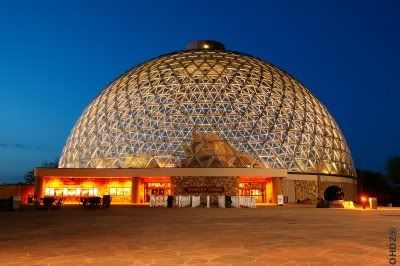 In part, I think these differences are directly affected by the available funding available . Money can bring certain animals to a zoo (like the Chinese pandads) and it can produce exhibits of higher quality. These high quality exhibits bring more and more people into the zoo to see these exhibits. Money also allows a zoo to provide better care to animals, provide better living conditions within the cages with more toys or more realistic environments, and hopefully these will provide a better situation for the animals . This zoo ranks poorly among other zoos across the nation mainly due to the audience that it draws and because of monetary issues.
In part, I think these differences are directly affected by the available funding available . Money can bring certain animals to a zoo (like the Chinese pandads) and it can produce exhibits of higher quality. These high quality exhibits bring more and more people into the zoo to see these exhibits. Money also allows a zoo to provide better care to animals, provide better living conditions within the cages with more toys or more realistic environments, and hopefully these will provide a better situation for the animals . This zoo ranks poorly among other zoos across the nation mainly due to the audience that it draws and because of monetary issues.Finally I began to wonder about the institution of a zoo. Was it solely for the entertainment of our youth or is there more behind the reasons for zoos? Zoos keep younger kids relatively entertained and they wear them out pretty easily. I believe there is another reason for zoos, one that is often over looked. These places are a center for learning; they can teach you about all the different species that are kept behind those bars. They can tell you interesting facts about animals you may never get the chance to learn about or see in your lifetime. Zoos provide us with a great place to gain knowledge about things that are unfamiliar to us. They are a fundamental learning site for us and the younger generations.
T.I.